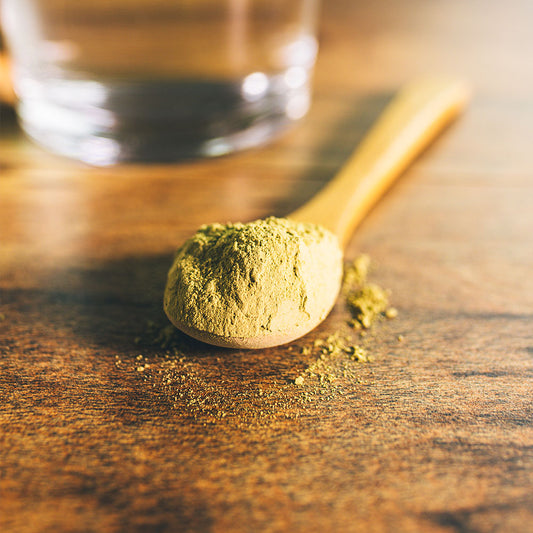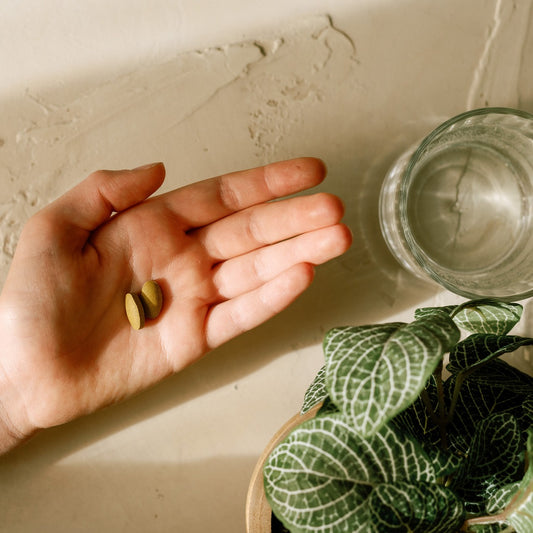Neem (Azadirachta indica) is a versatile and beneficial plant that has been celebrated for centuries. Use of neem dates back to at least 4,500 years, when this remarkable tree was already renowned in ancient India and adjacent countries.1
Today, neem's popularity continues to endure as more and more people throughout the world learn of its fantastic benefits and the many ways it can be used to support the body, mind, and spirit.
Buy Neem Now
In this article:
Characteristics of the Neem Plant
The neem tree belongs to the family Meliaceae—the mahogany family—and is a fast-growing, evergreen tree well known for its drought resistance. The neem tree matures into a large shade tree with a dense, round canopy and can live for 150–200 years.
And while neem is notorious for its strong, unpleasant taste, its flowers have a delicious honey-like scent that can be smelled for miles. As a fast-growing tree that needs little water, neem is also a very renewable resource.
In some parts of the world, the neem tree is called the "Village Dispensary" because each part of the plant possesses at least one health-promoting property.2
For thousands of years, various parts of the neem tree have been gathered for traditional health-promoting as well as practical everyday uses. The leaves, fruits, bark, and seed oil offer a wealth of benefits to the skin, nails, scalp, teeth, and gums.
Neem Benefits and Uses
In very general terms, neem is known to have an affinity for the reproductive system, the GI tract, the urinary tract, the respiratory system, and the circulatory system.3 Neem has also been known to benefit the following areas of the body as well.4
-
Skin and Blood. Neem is famous and celebrated for promoting healthy skin and a clear complexion. Due in part to its bitter taste, it has an incredibly cooling effect on the body, reducing excess heat that can manifest as skin blemishes.
-
Immune System. Its detoxifying effects on the body make it a great herb for supporting a healthy immune system, especially for the cleansing of ama (natural toxins) from the body.
-
Blood Sugar. The purifying benefits neem has on the body's blood and circulation also help support healthy blood sugar levels already in the normal range.
-
GI Tract. A healthy digestive environment is vital. Neem reduces unwanted heat and toxins in the GI tract.
-
Metabolism. Neem's kapha-reducing properties encourage proper fat and water digestion and elimination, keeping water retention from accumulating in the body.
-
Lungs. Neem supports clear breathing and a healthy respiratory system.
-
Hair. For those with excess pitta and heat trapped in the scalp and hair follicles, neem is terrific for cooling the scalp and supporting the growth of lustrous, smooth hair.
-
Teeth and Gums. Neem is highly effective in the maintenance of healthy teeth and gums and supports overall oral hygiene.
Neem in Ayurveda
Below is an overview of neem's effects on the doshas. If you do not know your yours, we recommend that you take our free dosha quiz.
-
Neem Balances Pitta. Neem is quite bitter in taste, which gives it a powerful cooling energy (virya). This cooling principle, combined with its capacity to support healthy blood, helps balance pitta—particularly when there is heat in rakta dhatu (the blood).5
-
Neem Balances Kapha. Neem's light and dry qualities give it the ability to counter kapha as well. Neem's kapha-reducing properties encourage proper fat and water digestion and elimination, keeping water retention from accumulating in the body.
-
Neem Can Aggravate Vata. Neem's cold, light, and dry qualities tend to aggravate vata. Neem is therefore often recommended in combination with other herbs that help subdue its vata-provoking nature.
Due to neem's powerful energetics, it is usually recommended to mix neem with other herbs when taking internally, use short-term, or take under the guidance of a practitioner.
Other Ayurvedic Uses
In Ayurveda, neem is known to kindle agni, or the digestive fire, within meda dhatu (the adipose tissue layer), encouraging proper metabolism. It is often taken internally to foster a state of balance in the liver, pancreas, and digestive tract.
Neem's bitterness also improves taste, which is at the root of healthy digestion. Neem has a similar balancing effect on pitta and kapha in prana vaha srotas (the respiratory passages).
On a broader scale, neem supports natural cleansing of the channels in the body as well as the rejuvenation of healthy tissues.6
How to Use Neem
Neem is a very versatile herb and can be taken internally or externally to support vibrant health. What follows are some of its most common uses.
How to Use Neem Internally
Banyan Botanicals makes certified organic neem available as a supplement in three forms:
-
As a Powder. Neem powder offers a traditional and economical way to take neem. Ayurveda traditionally recommends the powder form of herbs because tasting the herb starts the digestive process and sends signals to the body to initiate the body's own supportive mechanisms.
-
As a Tablet. Neem tablets provide a more convenient way to take neem, especially for those who are frequently traveling or on the go. Given neem's strong taste, the tablets also provide a nice alternative for those who find the taste a deterrent to taking the herb, while still getting a small sample of the taste for the benefits mentioned above.
How to Use Neem Externally
Externally, there are many ways to use neem for skin and hair care in particular. Below are some of Ayurveda's easiest and most traditional ways to support your health with neem from the outside in.
Neem Leaf Paste
Neem paste helps cool and soothe the skin, drawing excess heat.
To make a neem paste, combine neem leaf powder and a small amount of water—just enough to create the right paste-like consistency.
Apply paste to the desired area of skin and let sit for about 20 minutes, until it has nearly dried, then rinse off.
Herbal Neem Oil
Banyan's Neem Oil is a traditional Ayurvedic preparation of neem leaves blended into a sesame oil base. Neem Oil+ blends neem leaf with other cooling ingredients in an even more complex and well-rounded massage oil. Both of these oils are different from neem seed oil (pure oil extracted from neem seeds). Neem seed oil is quite potent and should be used appropriately. It is mentioned here for the sake of distinction from the traditional herbal preparation in sesame oil.
Neem Oil with sesame is often recommended for promoting healthy skin, nails, hair, and scalp. It also naturally cleanses the channels of the body and supports the rejuvenation of healthy tissues.7 Neem Oil can also be used as a deodorant for malodorous sweat.8
Here are a few more ideas about how to experience the benefits that Neem Oil has to offer:
For Healthy Skin and Nails. Apply Neem Oil directly to problem skin or nails, and either cover it loosely with a soft cloth or leave it uncovered and let it breathe and absorb.
For Healthy Hair. Massage Neem Oil directly into the roots of the hair and scalp at least 60 minutes before bathing and rinse. (Be sure to shampoo the hair before getting it wet to help get oil out of your hair.)
Or you can apply Neem Oil before bed and let sit overnight. (Remember to protect your linens from the oil, which will stain.)
For Oral Hygiene. Use Neem Oil for oil pulling to promote healthy teeth and gums. Swish to cover teeth and gums and spit.
You can also apply Neem Oil or neem paste (see above) directly to the teeth and gums. But if you're wondering, "Can I ingest Neem Oil?", we don't recommend it. Our Neem Oil was created as a massage oil, not for internal consumption.
Neem Products
Because neem is vata aggravating by itself, it is combined with other Ayurvedic herbs depending on the desired effect. Banyan offers the following, all made using neem paired with other complementary certified organic herbs:
-
Blood Cleanse tablets. Blood Cleanse combines five powerful blood purifiers that synergistically remove natural toxins from the blood, liver, and lymph—promoting healthy skin in the process.
-
Healthy Skin tablets. Healthy Skin uses many of the same herbs as Blood Cleanse, but is slightly less cooling, and is more specifically targeted toward supporting glowing, vibrant skin and a smooth complexion.
-
Sweet Ease tablets. Sweet Ease is a formula that nourishes the pancreas, balances kapha, and supports blood sugar levels that are already in a healthy range.
-
Neem & Aloe Soap. Neem & Aloe Soap is a gentle, cleansing soap that cools, soothes, and exfoliates the skin.
Soothing Skin Balm. Soothing Skin Balm is an herbal balm that replenishes the skin and promotes the natural rejuvenation process.
-
Immune Health NOW. Created during 2020, Immune Health NOW is a powdered herbal blend specially formulated to offer full-body support for robust health and a strong immune system.
-
Tooth Powder. Available in either mint cardamom or cinnamon clove, Tooth Powder blends powerful herbs and minerals well-known to cleanse the mouth, polish the teeth, and leave the whole mouth feeling refreshed and vitalized.

Modern Research on Neem
Modern scientists have described health-promoting uses for all parts of the neem tree—especially the leaves. Numerous studies have affirmed a wide range of applications for neem, and while these broad strokes are beyond the scope of this article, we can highlight a few of the findings.
- “Effect of neem leaf inclusion rates on compost physico-chemical, thermal, and spectroscopic stability.” PubMed Extract. Aug 2020.9
- “Utilization of Neem Leaf Extract on Biosynthesis of Iron Oxide Nanoparticles.” PubMed Extract. Oct 2019.10
- “Neem (Azadirachta indica): An Indian Traditional Panacea with Modern Molecular Basis.” PubMed Extract. Oct 2017.11
- “A comprehensive Review of Phytochemical Profile, Bioactives for Pharmaceuticals, and Pharmacological Attributes of Azadirachta indica.” PubMed extract. Jul 2018.12
- “Biological Activities and Medicinal Properties of Neem (Azadirachta indica).” Current Science. Oct. 2011.13
- “Medicinal Properties of Neem Leaves: A Review.” PubMed Extract, Oct. 2005.14
Is Neem Safe?
While neem has certainly stood the test of time and has been deemed safe with appropriate and moderate use, it remains a powerful herb and should be treated with respect, particularly when taken internally.
Neem can act as a refrigerant and can reduce the temperature of a specific tissue or even the entire body.15 Use caution if cold is a key player in any given condition. Discontinue use and consult your health care practitioner if there are any signs of nausea, vomiting, loose stools, or excess hunger.
Because herb/drug interactions have not been researched extensively, exercise caution when combining neem with prescription drugs.
- Some data suggests avoiding the use of neem while taking acetaminophen.
- Neem may intensify the effect of medications aimed at lowering blood pressure or blood sugar, causing blood sugar and blood pressure to drop.16
Contraindications
Neem should not be taken by any of the following persons:
- Infants or children
- Those who are pregnant or trying to conceive
- Those with allergies to any plants in the mahogany family17
- Anyone exhibiting extremely elevated vata, wasting (such as with bone loss), or debility18
Sustainability and Fair Trade in Action
In alignment with our commitment to fair trade principles, Banyan's neem is Fair for Life Fair Trade certified. Fair for Life looks at the entire journey of an ingredient, from harvest to the final product sold to our customers. It certifies social and environmental responsibility across an entire supply chain and within an entire business.
This third-party certification sets rigorous standards for how we treat our farmers and producers, as well as their environmental practices.
We also ensure the sustainability of Ayurvedic herbs by sourcing the botanicals used in our products from privately owned farms where each plant has been cultivated or harvested from legal wild-craft sourcing. Our herbs and ingredient-producing plants are harvested at optimal times, using environmentally sustainable practices sensitive to the long-term health of the plants.
1 Giri, Rudra Prasad, Dr. Ajit. Gangawane, and Dr. Sucheta Giri. “Neem the Wonder Herb: A Short Review.” International Journal of Trend in Scientific Research and Development Volume-3, no. Issue-3 (April 30, 2019): 962–67. https://doi.org/10.31142/ijtsrd23038
2 Lilot, Loetitia S. “The Neem Tree: The Village Pharmacy.” Ethnobotanical Leaflets 2000 (2000): 9. https://www.semanticscholar.org/paper/The-Neem-Tree
3 Pole, Sebastian. Ayurvedic Medicine: The Principles of Traditional Practice. Churchill Livingston Elsevier, 2006. 233-234.
4 “What is the Neem Plant and How is it Used?” Discover Neem. Online. 11 Nov. 2011. http://www.discoverneem.com/neem-plant.html
5 Pole, 327.
6 Masocco, Sonia E., comp. "Ayurvedic Herbology Student Handbook." 4th ed. Ayurvedic Institute, 2004. 74-75.
7 Ibid, 75.
8 Biswas.
9 Smith, Bryan A.M., Gaius Eudoxie, Robin Stein, Ravindra Ramnarine, and Vijaya Raghavan. “Effect of Neem Leaf Inclusion Rates on Compost Physico-Chemical, Thermal and Spectroscopic Stability.” Waste Management 114 (August 1, 2020): 136–47. https://doi.org/10.1016/j.wasman.2020.06.026
10 Zambri, Nur Diyana, Nurul Izza Taib, Famiza Abdul Latif, and Zakiah Mohamed. “Utilization of Neem Leaf Extract on Biosynthesis of Iron Oxide Nanoparticles.” Molecules 24, no. 20 (October 22, 2019): 3803. https://doi.org/10.3390/molecules24203803
11 Gupta, Subash Chandra, Sahdeo Prasad, Amit K. Tyagi, Ajaikumar B. Kunnumakkara, and Bharat B. Aggarwal. “Neem (Azadirachta Indica): An Indian Traditional Panacea with Modern Molecular Basis.” Phytomedicine 34 (October 15, 2017): 14–20. https://doi.org/10.1016/j.phymed.2017.07.001
12 Saleem, Sumaira, Gulzar Muhammad, Muhammad Ajaz Hussain, and Syed Nasir Bukhari. “A Comprehensive Review of Phytochemical Profile, Bioactives for Pharmaceuticals, and Pharmacological Attributes OfAzadirachta Indica.” Phytotherapy Research 32, no. 7 (April 19, 2018): 1241–72. https://doi.org/10.1002/ptr.6076
13 Biswas, Kausik, et al. “Biological Activities and Medicinal Properties of Neem (Azadirachta indica).” Current Science 82.11 (2002): 1336-1343. Online. 15 Oct. 2011. http://repository.ias.ac.in/5193/1/305.pdf
14 Subapriya, R., and S. Nagini. “Medicinal Properties of Neem Leaves: A Review.” Current Medical Chemistry: Anticancer Agents. 5.2 (2005): 149-146. Online. PubMed. 11 Oct. 2011. http://www.ncbi.nlm.nih.gov/pubmed/15777222
15 Pole, 233-234.
16 Giri.
17 Ibid.
18 Pole, 327.












